Companies prefer private Blockchain for security

The revolutionary impact of blockchain on business has affected a wide variety of industries around the world. From financial services to manufacturing and insurance. Cryptocurrency-based technology, such as Bitcoin, is ready to offer a fundamental redesign, unlocking reliance on trusted intermediaries and forever modifying understanding of the role and role of institutions and markets.
Blockchain opportunities have reached the executive levels of corporations worldwide, where business decision makers are fully aware of the main impacts of this technology on their processes and industries.
According to research conducted by ReportLinke, blockchain in the manufacturing market alone is expected to be worth $30 million by 2020 and grow at a compound annual growth rate of 80%, reaching 566 million dollars for 2025.
However, these same leaders, in the European area, seem to be more conservative than those in other countries or regions when judging the importance of blockchain. While European companies have identified innovative ideas on how blockchain could solve some of the most pressing problems in business and society today, there is a big gap in their path to turning those ideas into reality, about all from a strategic point of view.
It is therefore proposed that the first job for business leaders in Europe is Break with your more conservative models that limit the company, markets, business models and your way of competing, and start opening your minds to how blockchain could actually change the game.
In other words, companies must observe the rules that make up their industry or company, as well as their usual practices of executing business processes that can be interrupted by blockchain. It is necessary to dismantle the old conceptions of the use and value of certain products and services, as well as to redefine the purpose and value of the institutions themselves.
The gap in blockchain strategy
Most European companies see Blockchain as a strategic imperative, Cognizant says in its report “Blockchain in Europe: Closing the Strategy Gapel”,where it shows that 83% of the companies expect this technology to have a significant or very important impact on their industry, even if they are still not sure how to do it.
However, currently, most European companies are using blockchain as a new way to complete existing tasks rather than innovate.
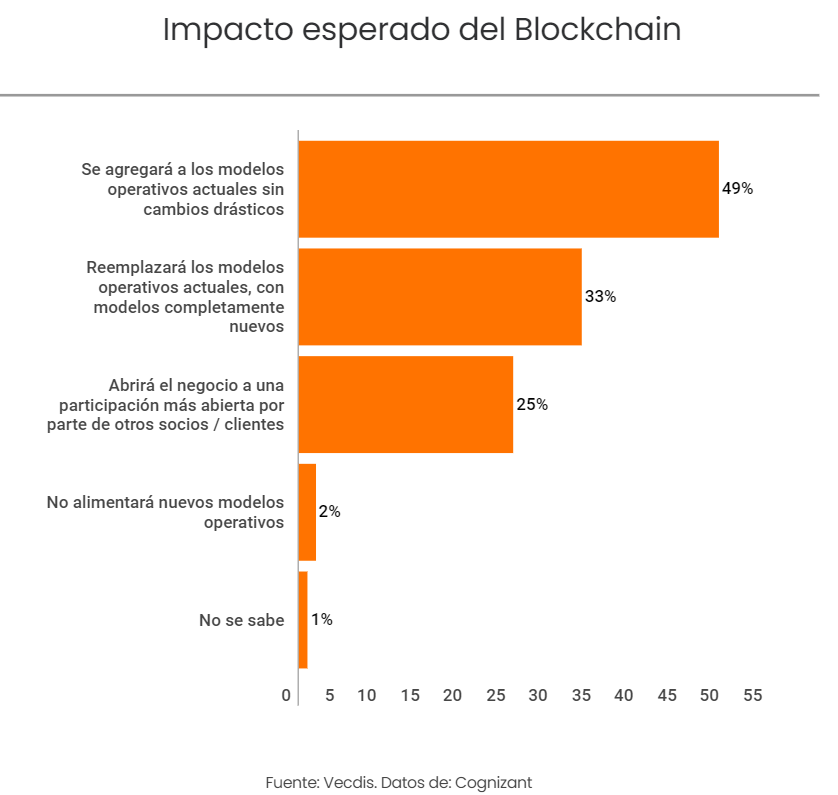
Breaking old models and investing new ones
The open ecosystem approach required by blockchain will require a drastic change of mindset, including the need to collaborate with external partners in a way that few traditional companies have done so far.
Most companies work with blockchain technology internally, only a third of companies have decided to work with external resources, such as industry partners or competitors.
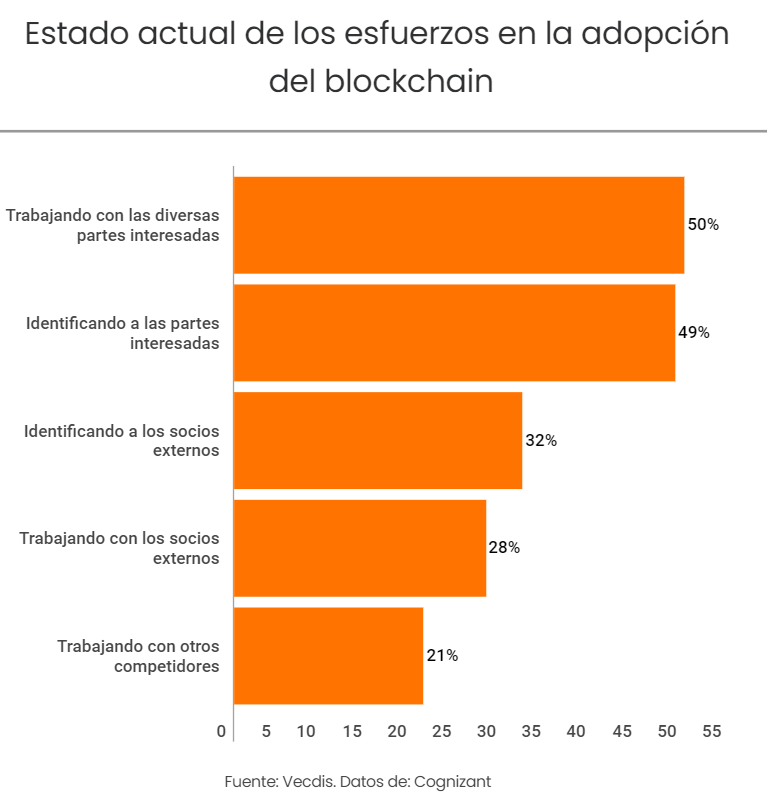
At the same time, several industrial consortia have been formed in Europe, allowing companies belonging to the same industry to collaborate with each other. An example is the project European Digital Trade Chain, founded by a consortium of banks to build a blockchain-based platform for commercial financing, with the aim of addressing the liquidity problem in global supply chains and enabling small and medium-sized enterprises to have a better access to European markets.
Another example is B3i, a consortium of European insurers working to apply distributed accounting technology to improve back-office efficiency. However, experts report that progress has been slow in some consortia, as many of the participants prefer to push their own agenda.
That’s why adopting a collaborative approach will be a challenge for most companies. Business leaders need to be comfortable with the idea of new platform-based business models, shared industrial economy, data security, or cryptography.
This change of mindset can be achieved by engaging business and IT leaders in learning and collaboration, using a process of innovation based on design thinking to gain a practical experience of how blockchain technology can address a well-defined, substantial and real business problem in an ecosystem or market.
For example, the European Commission is doing this in its initiative #Blockchain4EU, whose mission is to identify, discuss and communicate possible uses and impacts of the blockchain, mainly through participation and co-creation workshops taught by stakeholders to influence the formulation of new policies in the European Union.
The main purpose
Another challenge companies face is discovering the systemic problems of this technology that “transformation allocated” exists behind it, and to design a market, platform or trusted zone that addresses the problem.
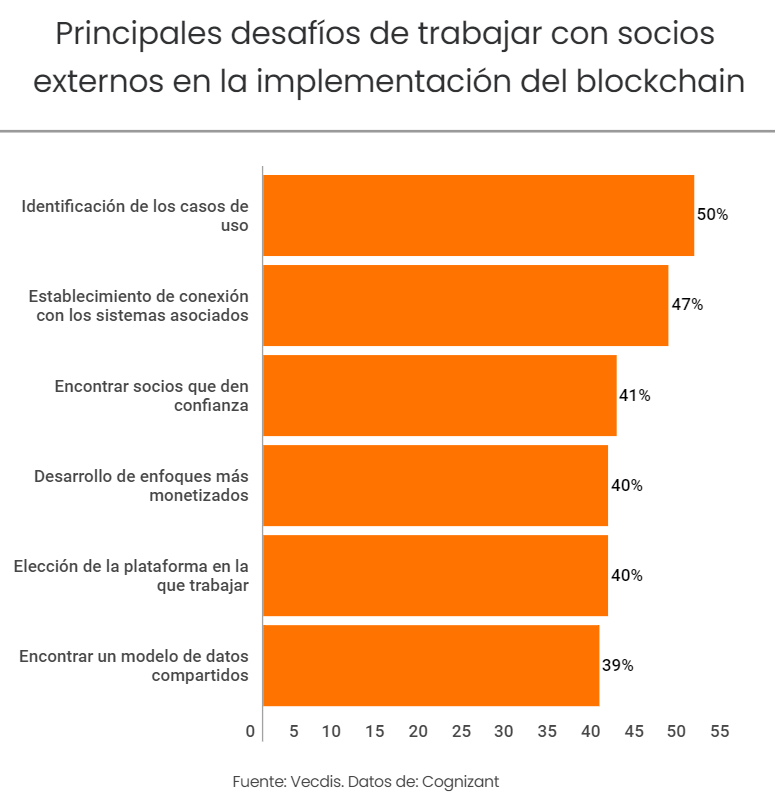
To advance the identification of blockchain cases and strategies, European companies will need to overcome years of ingrained conventional individual wisdom. Instead of focusing on the existing business, companies should imagine possible scenarios where blockchain will change value chains, markets and institutions.
They can do this using a scenario-based planning approach, called”future mapping”. This approach can help companies and their ecosystem partners develop a blockchain strategy based on future scenarios, especially in relation to ecosystems, platforms and how blockchain technologies could enable them and create them new market opportunities and address significant problems. The result of such a scenario based on the blockchain strategy should be a list showing the priority of each use case.
Developing a prototype
Many companies in Europe are already working on several blockchain use cases for a wide range of areas, with particular relevance in financial and IT operations. Compared to US companies, European companies have had a smaller impact, but this technology has particular relevance in the supply chain and acquisitions.
The financial services sector remains the most advanced in adopting blockchain solutions. Most major European banks are testing this technology in a number of areas, including BNP Paribas, which has already processed some live payments and is also testing international treasury operations to improve management efficiency internal cash between companies.
This solution improved the interoperability of the bank and its legacy systems through the use of robots and APIs, which allowed a private blockchain to be integrated with the existing computing environment.
On the other hand, the main internal barriers to adopting blockchain, are related to the understanding of blockchain technology and its possible use, in addition to weighing the costs and benefits it offers and once its implementation is decided, communicate to all the staff what new news will offer the company.
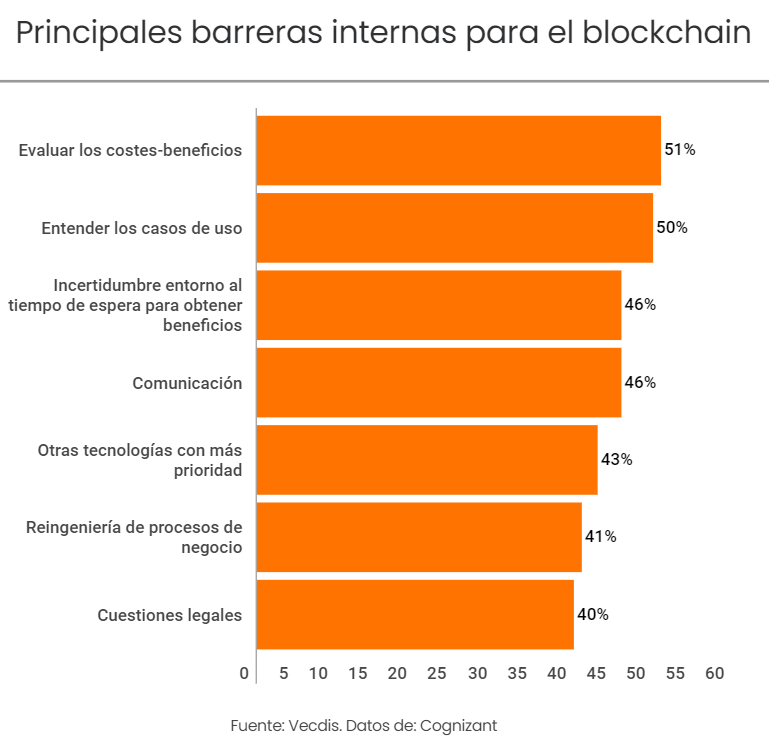
Many companies and consortia too often focus their attention on assessing the viability of the technology or comparing different blockchains (e.g. Hyperledger vs. Ethereum vs. Ethereum Corda / R3, and public vs. and to develop a small proof of concept and prototype.
While this is an important step in the learning process, it often diverts attention from the need to focus on platform mechanisms. Most companies are experimenting with private or authorized blockchain use cases, rather than open or public blockchains, as they see greater risk by exposing critical data, which makes concerns surrounding their security increase.
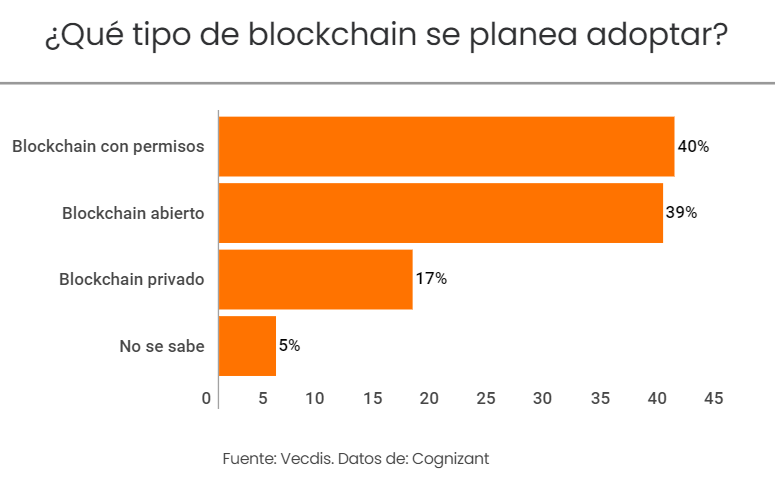
Regardless of whether private or public blockchain frameworks are the preferred solutions for use, the business model is usually still based on a platform that requires design. However, designing platform-based blockchain use cases requires organizations to work together with other ecosystem partners to design the trusted zone and its management mechanisms rather than focusing only on technological issues.
There are some guidelines that can help companies start planting a prototype in the right direction.
- Establish the purpose and global goals of transformation. Companies can start the adoption of the blockchain by identifying the problems they want to solve and quantifying the impact of solving them. The next key question would be aimed at figuring out how the unique features of blockchain can help solve at least part of the problem. This requires a deep understanding of how cryptoeconomics works.
- Draw the boundaries of the ecosystem. A deep understanding of the problems to be solved will draw a clear picture of the opportunity space and its boundaries, i.e. the key players that will be included in the trusted zone.
- Assess potential risks, barriers and pitfalls. Regulatory issues are a key area for overcoming risks and barriers. This is particularly true when cryptocurrencies and utility tokens are involved in the use case, but even the business model configuration will need to get some kind of regulatory approval. Other risks are related to antitrust laws, in this case, the governance of the consortium should incorporate appropriate enforcement and enforcement measures.
- Define rules and governance mechanisms. The main business innovation is that rules and incentives must be coded in the blockchain. Most blockchain implementations are in the real world, however, solutions require hybrid solutions, where part of the rules and incentives are “chained” and the parties are “out of the chain”. Therefore, key rules include how to share assets, intellectual property, risks and returns, collective election rules, and the definition of governance mechanisms on how to monitor compliance.
- Define requirements. The definition of requirements must be exploratory, following an iterative design process, using prototypes and various components of blockchain technology. The set of requirements identified in this process should drive platform decisions.
- Choose the blockchain platform and business integration approach. This choice will be based on the requirements defined above. The appropriate blockchain architecture must be chosen and designed, using various technological components. On this basis, a more detailed design can be produced, based on the characteristics of the chosen framework.
Large software companies such as Microsoft and SAP already provide BaaS platforms to facilitate blockchain usage prototypes and enterprise integration. For example, SAP launched its ready-to-use blockchain technology as part of its Leonardo product line, to be fully integrated with SAP applications. The solution also enables immutable data exchanges between business processes that may not be hosted in an SAP cloud.
As many organizations rely on large software vendors like SAP to run their core processes in their software, such BaaS offerings will significantly drive blockchain adoption beyond the financial realm. Most importantly, however, these offerings will significantly reduce the barriers that small and medium-sized enterprises will encounter to adopt blockchain.
Conclusions
In a short time, blockchain technology has scaled from limited cryptocurrency-related applications to the attention of many highly respected and successful business leaders.
Of course, skepticism about his success still persists. It is true that the blockchain does not conform to the most traditional mental models and many strategic applications, the challenges continue, including scalability, latency and integration with enterprise applications.
Therefore, although most large European companies are already working on blockchain use cases, adoption from a business computing perspective could be slow. Meanwhile, other geographic regions, such as Asia-Pacific, which are also investing heavily in blockchain are advancing rapidly.
However, there is also a positive side, where corporate Europe is a powerhouse when it comes to know-how, infrastructure and trained personnel. However, this asset can quickly become a liability, as Europe has an “legacy problem”; for example, many manufacturing assets will soon be out of date and will require significant investment to keep up in terms of efficiency and degree of automation. Knowledge will also be quickly outdated.
The main cause of the problem is probably cultural: many companies are trapped in the mentality and ways of working that have made them successful over the past 50 years. That’s why it’s important for companies to change that traditional mindset first and imagine the future more innovative.


